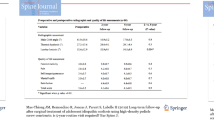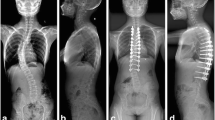Abstract
Study Design
Retrospective, comparative analysis.
Objectives
Comparative analysis was performed to determine the differences, if any, between adolescent idiopathic scoliosis (AIS) patients who underwent posterior spinal fusion (PSF) with and without cross-links.
Summary of Background Data
Cross-links are frequently used during PSF for AIS. It is unclear whether they provide any advantage for patients with all—pedicle screw constructs.
Methods
A prospectively collected multicenter database of patients with AIS undergoing spinal fusion was retrospectively queried. Study inclusion criteria were primary PSF with all–pedicle screw fixation (greater than 90% fixation points) and minimum 2 years’ follow-up. Collected data included demographics, radiographic measures, complications, Scoliosis Research Society–22r and Spinal Appearance Questionnaire (SAQ) scores.
Results
A total of 500 patients were included (377 cross-link and 123 non–cross-link). Age, body mass index, gender, and preoperative major Cobb angle were not different between groups. Except for a slightly decreased lumbar Cobb angle (2.7°) in the cross-link group, no other radiographic measures were different at follow-up. Complications were not significantly different between groups: 21 of 377 (6%) crosslink and 9 of 123 (7%) non–cross-link. Infection occurred in 1 patient in the cross-link group and none in the non–cross link group. Reoperation occurred in 4 patients, all with cross-links (3 for implant removal and 1 for distal adding-on). Scoliosis Research Society–22r scores, total and individual domains, improved by a similar amount in both groups. At follow-up, parent and patient SAQ appearance scores were not significantly different. The SAQ expectations domain scores were similar for all visits and improved for both patients and parents.
Conclusions
There do not appear to be significant clinical or radiographic outcome differences in patients with AIS undergoing PSF based on the use of cross-links at 2-year follow-up. Surgeons should consider eliminating cross-links in patients with AIS who have PSF with all–pedicle screw constructs. This may have substantial cost savings without affecting patient outcome.
Similar content being viewed by others
References
Kuklo TR, Dmitriev AE, Cardosi MJ, et al. Biomechanical contribution of transverse connectors to segmental stability following long segment instrumentation with thoracic pedicle screws. Spine (Phila Pa 1976) 2008;33:E3–7.
Chutkan NB, Zhou H, Akins JP, Wenger KH. Effects of facetectomy and crosslink augmentation on motion segment flexibility in posterior lumbar interbody fusion. Spine (Phila Pa 1976) 2008;33:E3–35.
Brodke DS, Bachus KN, Mohr RA, Nguyen BK. Segmental pedicle screw fixation or cross-links in multilevel lumbar constructs. a biomechanical analysis. Spine J 2001;1:373–9.
Wood KB, Wentorf FA, Ogilvie JW, Kim KT. Torsional rigidity of scoliosis constructs. Spine (Phila Pa 1976) 2000;25:1893–8.
Lim TH, Kim JG, Fujiwara A, et al. Biomechanical evaluation of diagonal fixation in pedicle screw instrumentation. Spine (Phila Pa 1976) 2001;26:2498–503.
Dhawale AA, Shah SA, Yorgova P, et al. Effectiveness of crosslinking posterior segmental instrumentation in adolescent idiopathic scoliosis: a 2-year follow-up comparative study. Spine J 2013;13:1485–92.
Kulkarni AG, Dhruv AN, Bassi AJ. Should we cross the cross-links? Spine (Phila Pa 1976) 2013;38:E3–34.
Wilson PL, Newton PO, Wenger DR, et al. A multicenter study analyzing the relationship of a standardized radiographic scoring system of adolescent idiopathic scoliosis and the Scoliosis Research Society outcomes instrument. Spine (Phila Pa 1976) 2002;27:2036–40.
Carreon LY, Sanders JO, Diab M, et al. The minimum clinically important difference in Scoliosis Research Society-22 Appearance, Activity, And Pain domains after surgical correction of adolescent idiopathic scoliosis. Spine (Phila Pa 1976) 2010;35:2079–83.
Adobor RD, Rimeslåtten S, Keller A, Brox JI. Repeatability, reliability, and concurrent validity of the scoliosis research society-22 questionnaire and EuroQol in patients with adolescent idiopathic scoliosis. Spine (Phila Pa 1976) 2010;35:206–9.
Bago J, Pérez-Grueso FJ, Les E, et al. Minimal important differences of the SRS-22 Patient Questionnaire following surgical treatment of idiopathic scoliosis. Eur Spine J 2009;18:1898–904.
Carreon LY, Sanders JO, Polly DW, et al. Spinal appearance questionnaire: factor analysis, scoring, reliability, and validity testing. Spine (Phila Pa 1976) 2011;36:E3–4.
Scholten PJ, Veldhuizen AG. Analysis of Cobb angle measurements in scoliosis. Clin Biomech (Bristol, Avon) 1987;2:7–13.
Cook S, Asher M, Lai SM, Shobe J. Reoperation after primary posterior instrumentation and fusion for idiopathic scoliosis: toward defining late operative site pain of unknown cause. Spine (Phila Pa 1976) 2000;25:463–8.
Asher M, Lai SM, Burton D, et al. Safety and efficacy of Isola instrumentation and arthrodesis for adolescent idiopathic scoliosis: two- to 12-year follow-up. Spine (Phila Pa 1976) 2004;29:2013–23.
Kim YJ, Bridwell KH, Lenke LG, et al. Pseudarthrosis in primary fusions for adult idiopathic scoliosis: incidence, risk factors, and outcome analysis. Spine (Phila Pa 1976) 2005;30:468–74.
Nash Jr CL, Moe JH. A study of vertebral rotation. J Bone Joint Surg Am 1969;51:223–9.
Upasani VV, Chambers RC, Dalal AH, et al. Grading apical vertebral rotation without a computed tomography scan: a clinically relevant system based on the radiographic appearance of bilateral pedicle screws. Spine (Phila Pa 1976) 2009;34:1855–62.
Kuklo TR, Potter BK, Polly Jr DW, Lenke LG. Monaxial versus multiaxial thoracic pedicle screws in the correction of adolescent idiopathic scoliosis. Spine (Phila Pa 1976) 2005;30:2113–20.
Liljenqvist U, Hackenberg L, Link T, Halm H. Pullout strength of pedicle screws versus pedicle and laminar hooks in the thoracic spine. Acta Orthop Belg 2001;67:157–63.
Author information
Authors and Affiliations
Corresponding author
Additional information
Author disclosures: SG (personal fees from DePuy Synthes Spine, outside the submitted work); CN (none); ZP (none); ME (other from Biomet, outside the submitted work).
Rights and permissions
About this article
Cite this article
Garg, S., Niswander, C., Pan, Z. et al. Cross-Links Do Not Improve Clinical or Radiographic Outcomes of Posterior Spinal Fusion With Pedicle Screws in Adolescent Idiopathic Scoliosis: A Multicenter Cohort Study. Spine Deform 3, 338–344 (2015). https://doi.org/10.1016/j.jspd.2014.12.002
Received:
Revised:
Accepted:
Published:
Issue Date:
DOI: https://doi.org/10.1016/j.jspd.2014.12.002




